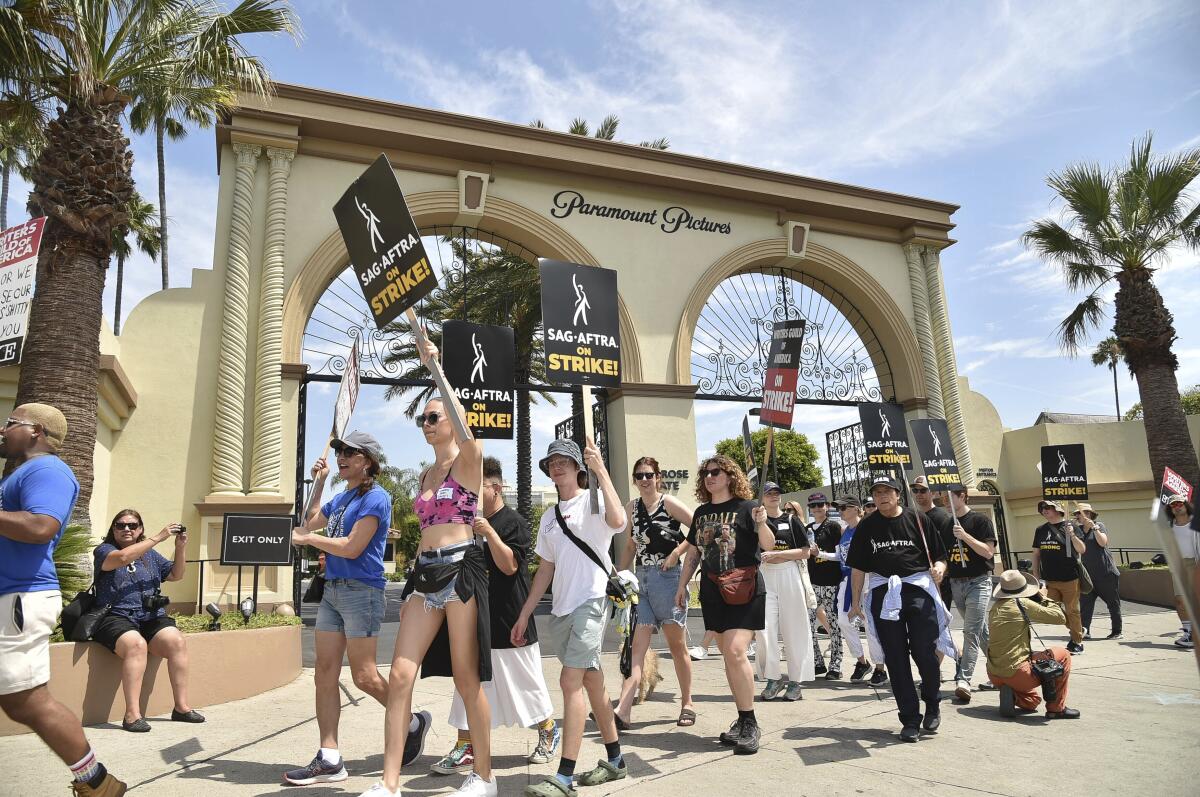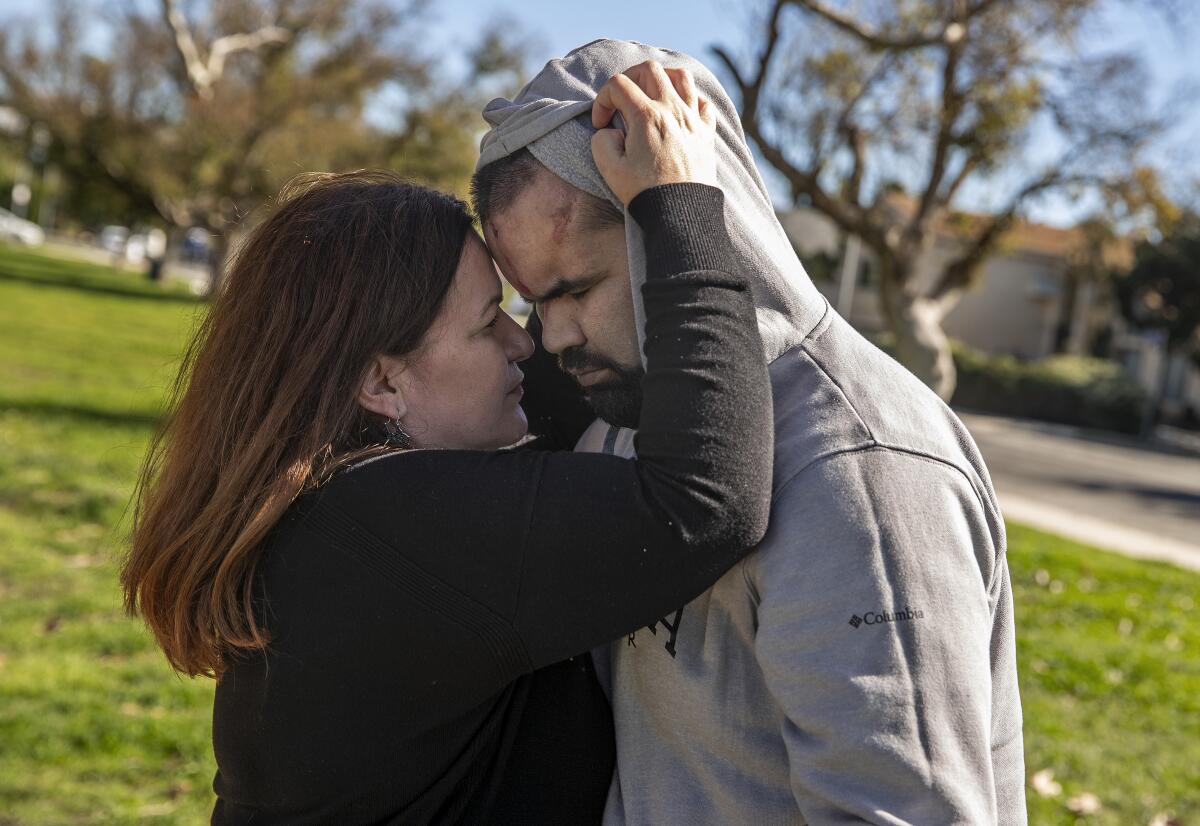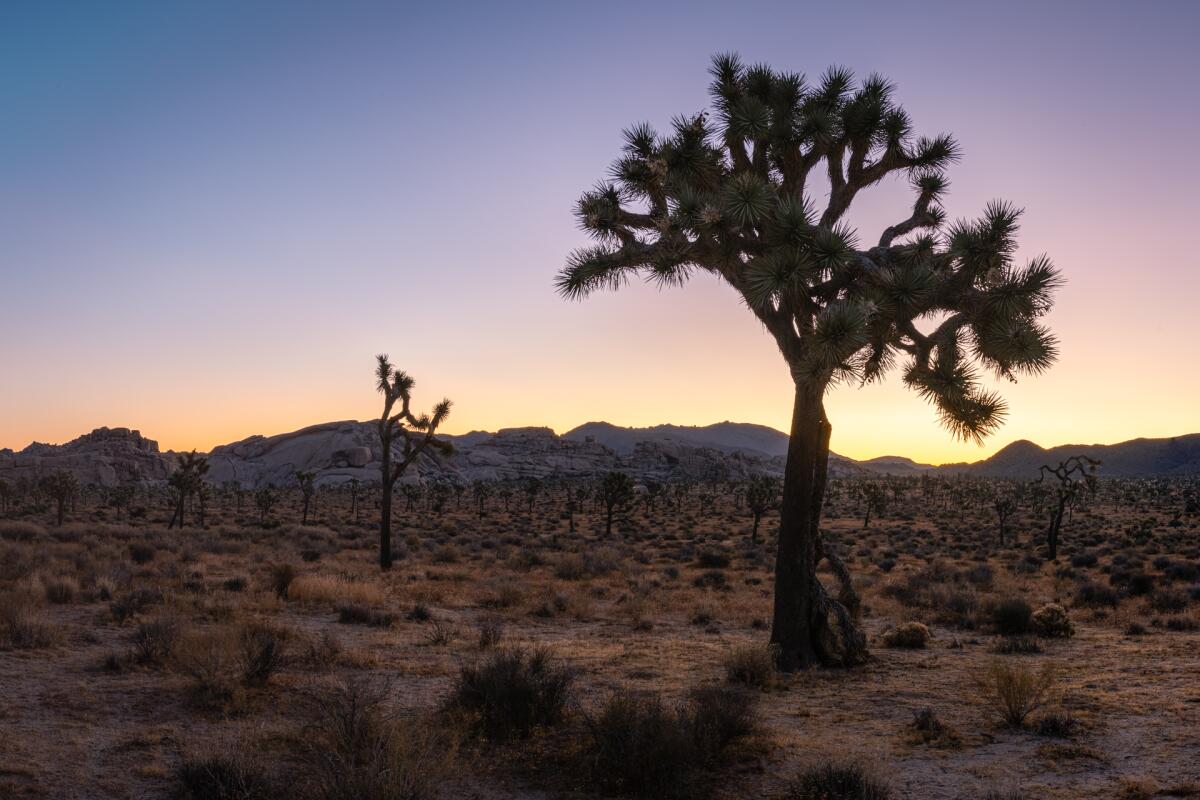California’s filming exodus leaves Hollywood’s essential workforce sidelined

- Share via
Good morning. It’s Tuesday, March 26. Here’s what you need to know to start your day.
- Tightened budgets and out-of-state shoots jeopardize Hollywood’s workers
- A rare late-season storm could hit SoCal during Easter weekend
- The best sunrise views in Joshua Tree
- And here’s today’s e-newspaper
Sign up for Essential California
The most important California stories and recommendations in your inbox every morning.
You may occasionally receive promotional content from the Los Angeles Times.
Why it’s taking so long to get Hollywood back to work
Hollywood’s essential workers are ready to work after nearly half a year of overlapping work stoppages from last year’s writers’ and actors’ strikes. However, many of them are struggling to find jobs due to a slow recovery.
After the Writers Guild of America and the Screen Actors Guild-American Federation of Television and Radio Artists resolved labor disputes, entertainment companies and workers alike seemed eager to turn the lights back on. But a decline in filming activity and job opportunities in California persists — a trend that entertainment workers observed as early as the end of 2022.
The Times’ Christi Carras and Marisa Gerber examined Hollywood’s desire to return to work and why it is taking so long.
Studio projects leaving L.A.
Major studios were desperate to salvage the 2024 film schedules, and creatives, performers and crew members couldn’t wait to get back on set and start making money again. However, filming has not rebounded as swiftly as anticipated — at least, not in California.
The number of on-location shoot days in the L.A. area was down 26% in January compared to the same month in 2023, according to FilmLA. Smaller, independent projects, employing fewer cast and crew members, have received the majority of filming permits compared to major studios and streaming productions.
Since the strike settled, top entertainment companies have been notably absent from filming in L.A. The decreasing volume of major motion pictures shot in California continues a long-term pattern.
- Disney has 22 live-action films in various stages of production, roughly three of which are based in California.
- Warner Bros. only has one feature out of seven filming in California.
- Sony has begun production on six movies, with one slated to shoot in California.
- Universal Pictures has 11 films in production or pre-production, and none were shot or set to shoot in the Golden State.
The cost of doing business in California
Worsening matters, California is finding it challenging to recover from the walkouts because shooting here is more expensive, multiple production executives told The Times. This expense makes L.A. less appealing to studios seeking cost-cutting options after a significant industry disruption.
“California — while it has its advantages — sits in the wrong place for a moment like this,” said one Hollywood producer who was unauthorized to comment.
Filming activity in the Greater L.A. area had already declined by the end of 2022, according to the nonprofit FilmLA, which monitors on-location shoots and filming permits in L.A.
“Given that 40% of production employment is based in Southern California for the country ... that makes L.A. significantly more important and significantly more impacted when the entertainment industry has a problem,” said Kevin Klowden, executive director of MI finance at the Milken Institute.
Industry experts and insiders attribute the ongoing exodus of productions from California to tax credit incentives offered by other popular filming destinations, such as Georgia, New Mexico, New York, Louisiana and the United Kingdom, which California has failed to compete with.
As other production hubs “continue to develop around the world, we have to find ways to be more competitive,” said FilmLA president Paul Audley. “And I frankly don’t anticipate that changing given what we’re hearing out of Sacramento at this point.”
The effects the decline has on Hollywood’s essential workforce
In the aftermath of the streaming wars — which saw several companies greenlight an excess of content in an effort to compete with Netflix — the studios have been tightening their belts, slashing their staffs, restructuring their businesses and slimming down their production budgets and slates.
TV, film and commercial shoots are a sizable driver of employment, not just for Hollywood’s elite but also for the industry’s below-the-line laborers, craftspeople and myriad ancillary businesses that keep the industry moving.
The slow bounce back post-strike has already impacted small businesses that depend on the steady flow of Hollywood production for revenue, including local prop houses, florists, marketing agencies, drivers and dry cleaners.
“Before the strikes, you really felt the production beating through the city,” said Olivia Cain, a set medic based in North Hollywood who has worked on several films and TV series. “And now, you don’t even want to ask your friends how they’re doing because you know exactly what the answer is. No one’s working. No one’s received a call.”
“It’s been sloooooooow,” added Mimi Clarke, vice president of Front Row Media, an entertainment marketing agency specializing in product placement in movies. “January was a blip, February a bit more, March a bit more, but it’s not where it should be.”
These days, Clarke noted that the agency only receives about half as many weekly inquiries compared to late 2022. She added that much of the new business is for productions in other filming hotspots like Atlanta, Albuquerque and Croatia.
“L.A. is even quieter,” she said.
Today’s top stories

California insurance crisis
- State Farm won’t renew 72,000 insurance policies in California, worsening the state’s insurance crisis.
- California’s home insurer of last resort sees an enrollment surge, raising concerns over its finances.
- A major auto insurer returns to California — with a 30% price hike.
Death in L.A. County jails
- Why was 2023 such a deadly year in Los Angeles County jails? It depends on whom you ask.
- How many people die each year in jails and prisons? No one knows.
- A man was beaten to death in Men’s Central Jail. It took staff nearly four hours to notice.
Job growth (or lack thereof) in California
- Where is the nation’s lowest job growth? Look no further than rural California.
- Job growth is booming across the U.S. but not in California. Here’s why.
Donald Trump trials
- A court agrees to hold off collection of Trump’s $454-million fraud judgment if he puts up $175 million.
- A New York judge has scheduled an April 15 trial date in former President Trump’s hush money case.
Abortion pill usage in the U.S.
- The Supreme Court’s anti-abortion conservatives could restrict abortion pills sent by mail, even in blue states.
- Abortion pill usage surged post-Roe. These numbers show the dramatic rise.
Cease-fire in Gaza
- The U.S. relents, allowing U.N. passage of demand for a cease-fire in Gaza.
- U.S. Gaza resolution is vetoed at the U.N. as Blinken fails to achieve a breakthrough in Israel.
- A proposed U.S. resolution would back global efforts for an immediate and sustained cease-fire in Gaza.
More big stories
- Shohei Ohtani says he never bet on sports in first remarks since Ippei Mizuhara accusations.
- Feds raid Sean ‘Diddy’ Combs’ L.A., Miami homes in sex-trafficking inquiry, sources say.
- California extends deadline for students seeking state financial aid amid FAFSA turmoil.
- Yes, beavers can help stop wildfires. And more places in California are embracing them.
- Lawsuits and political backlash: Dodger Stadium gondola faces more roadblocks.
- Jill Biden’s swing through Southern California: Fundraisers, protesters and a stop at SoulCycle.
- Ready for more rain in SoCal? A rare late-season storm could hit during Easter weekend.
- In a time of rising campus antisemitism, USC gives its highest honor to Holocaust survivors.
- A girl grabs a deputy’s gun, and fatally shoots herself in the lobby of a L.A. County sheriff’s station, officials say.
- Tuberculosis cases are rising in California, and state officials are sounding the alarm.
- Biden, at risk with young voters, is racing to shift marijuana policy.
- A judge dismisses Elon Musk’s lawsuit against anti-hate watchdog on free-speech grounds.
- Southern California hotel workers ratify new contracts, ending strikes for some.
Get unlimited access to the Los Angeles Times. Subscribe here.
Commentary and opinions
- Jonah Goldberg: Why Trump’s running mate is less likely to be Marco Rubio than Marjorie Taylor Greene.
- LZ Granderson: A new ban on Pride flags at U.S. embassies is more than bad optics.
- Dylan Hernández: Gambling and theft allegations raise one big question. Who is Shohei Ohtani?
- Bill Shaikin: The Dodgers are expected to win. But has MLB stacked the odds against them?
- Doyle McManus: Trump wants to round up over a million undocumented migrants from California. Here’s how he might do it.
Today’s great reads

Adults with autism faced ‘torture’ at this L.A. group home. Their moms want justice. The violence captured on video at Elwyn-Mayall has raised questions about the Northridge home’s prominent role as caregiver for some of the most vulnerable Californians — and whether oversight bodies are prepared to keep troubled homes in check amid a severe shortage in beds.
Other great reads
- Weezer’s Blue Album at 30: The inside story of the debut that launched L.A.’s nerdiest band.
- A fall from on high: What happened to MedMen — the Apple store of cannabis?
How can we make this newsletter more useful? Send comments to [email protected].
For your downtime
Going out
- 🌅 An epic quest led Times contributor Maggie Downs to the best sunrise views in Joshua Tree.
Staying in
- 📺 This cut backstory explains the most intriguing relationship in Netflix’s ‘3 Body Problem.’
- 🥕 Here’s a recipe for carrot ribbon salad.
- ✏️ Get our free daily crossword puzzle, sudoku, word search and arcade games.
And finally ... a great photo
Show us your favorite place in California! We’re running low on submissions. Send us photos that scream California and we may feature them in an edition of Essential California.

Today’s great photo is from Times photographer Brian van der Brug at the Klamath River, which has returned to its ancient channel and is flowing unhindered for the first time in more than a century through miles of waterlogged lands.
Have a great day, from the Essential California team
Anthony De Leon, reporting fellow
Kevinisha Walker, multiplatform editor
Stephanie Chavez, deputy metro editor
Check our top stories, topics and the latest articles on latimes.com.
Sign up for Essential California
The most important California stories and recommendations in your inbox every morning.
You may occasionally receive promotional content from the Los Angeles Times.





